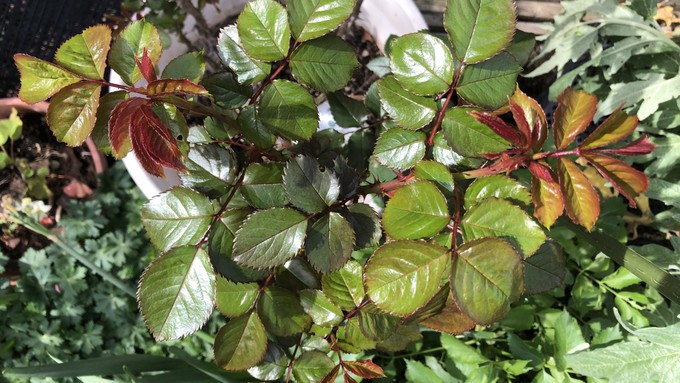
Expect a soggy end to winter and start of spring

This happy little rose bush is putting out a lot of new growth. Be sure to feed roses now and watch out for aphids. Kathy Morrison
Appropriately, winter will end on a wet note – and spring will start a little soggy, too.
According to the National Weather Service, Sacramento can expect rain on Sunday, the last day of winter. Those showers will linger into Monday, the first day of spring.
“Definite rain showers” are in Sunday’s forecast, starting at 7 a.m., says the weather service.
Most of this storm’s moisture is likely headed for the Sierra, with heavy snow expected in the passes. Meanwhile in Sacramento, we’ll get between one-fourth and one-half inch of rain, the forecast says.
Keep those umbrellas handy. According to the weather service, more rain is expected Tuesday through Friday with off and on showers.
These storm clouds will really cool down our temperatures. After enjoying warm springlike temperatures on Saturday, we’ll be back in the low 50s by Tuesday with a high of 52 predicted. Overnight lows will be chilly, too, plunging to 41 degrees (or colder) on Thursday and Friday.
Normal for this week of March: Highs of 68 degrees and lows of 46.
All this cold and wet will keep our soil cooler longer – not good for tomatoes. According to UC Davis, local soil temperatures are still in the 51 to 53 degree range, more than 10 degrees colder than what tomatoes need to start growing.
Hold off on putting any summer veggies in the ground at least two more weeks. If you can’t sit comfortably on bare ground in your underwear, it’s too cold to transplant tomatoes.
There’s still plenty to do between showers:
* Fertilize roses, annual flowers and berries as spring growth begins to appear.
* Watch out for aphids. Wash off plants with strong blast from the hose.
* Pull weeds now! Don’t let them get started. Take a hoe and whack them as soon as they sprout.
* Prepare summer vegetable beds. Spade in compost and other amendments.
* Prune and fertilize spring-flowering shrubs after bloom.
* Feed camellias at the end of their bloom cycle. Pick up browned and fallen flowers to fight blossom blight.
* Feed citrus trees as they start to blossom.
* Cut back and fertilize perennial herbs to encourage new growth.
* Seed and renovate the lawn (if you still have one). Feed cool-season grasses such as bent, blue, rye and fescue with a slow-release fertilizer. Check the irrigation system and perform maintenance. Make sure sprinkler heads are turned toward the lawn, not the sidewalk.
* In the vegetable garden, transplant lettuce and kale.
* Seed chard and beets directly into the ground.
* Plant summer bulbs, including gladiolus, tuberous begonias and callas. Also plant dahlia tubers.
* Shop for perennials. Many varieties are available in local nurseries and at plant events. They can be transplanted now while the weather remains relatively cool.
Comments
0 comments have been posted.Sacramento Digs Gardening to your inbox.
Sites We Like
Garden Checklist for week of July 21
Your garden needs you!
* Keep your vegetable garden watered, mulched and weeded. Water before 8 a.m. to reduce the chance of fungal infection and to conserve moisture.
* Feed vegetable plants bone meal, rock phosphate or other fertilizers high in phosphate to stimulate more blooms and fruiting. (But wait until daily high temperatures drop out of the 100s.)
* Don’t let tomatoes wilt or dry out completely. Give tomatoes a deep watering two to three times a week.
* Harvest vegetables promptly to encourage plants to produce more. Squash especially tends to grow rapidly in hot weather. Keep an eye on zucchini.
* Pinch back chrysanthemums for bushy plants and more flowers in September.
* Remove spent flowers from roses, daylilies and other bloomers as they finish flowering.
* Pinch off blooms from basil so the plant will grow more leaves.
* Cut back lavender after flowering to promote a second bloom.
* It's not too late to add a splash of color. Plant petunias, snapdragons, zinnias and marigolds.
* From seed, plant corn, pumpkins, radishes, winter squash and sunflowers.